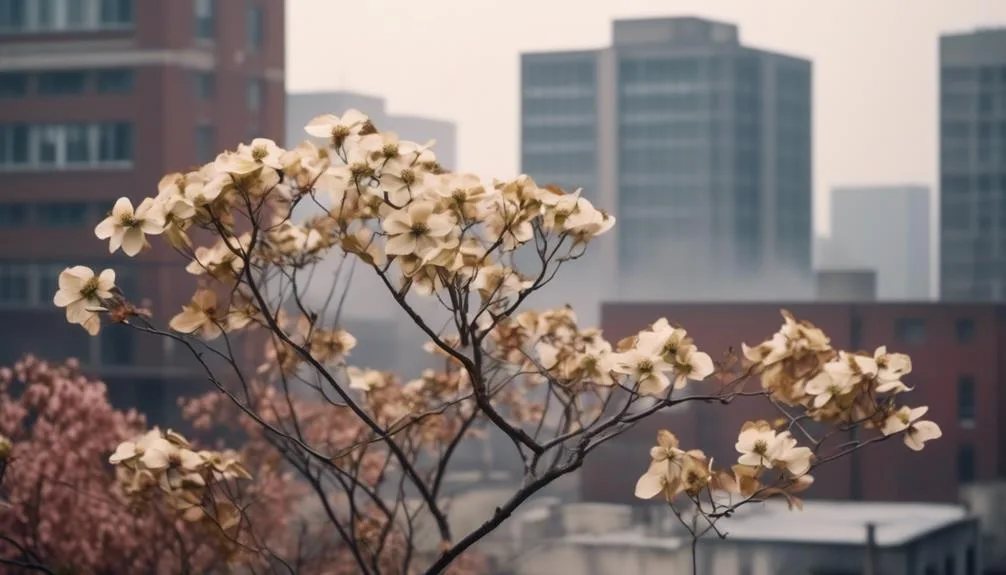Dogwood trees, often admired for their delicate beauty, may seem vulnerable to pollution. However, these trees have surprising resilience.
As urban areas grapple with air pollution, the question of whether dogwood trees can endure these harsh conditions gains significance. Can they thrive in polluted air?
Let's dive into the world of dogwood trees and their relationship with pollution to find out.
Tolerance to Air Pollution
If you live in an area with high air pollution, dogwood trees demonstrate remarkable tolerance to the adverse effects of pollution. Their ability to thrive in such conditions is partly due to their adaptability to various soil compositions. Dogwood trees can grow in both acidic and alkaline soils, making them resilient in urban environments where soil quality may be compromised.
Additionally, their leaf morphology plays a crucial role in their tolerance to pollution. Dogwood leaves have a large surface area, allowing them to efficiently absorb pollutants from the air. The leaves also have microscopic hairs that trap particulate matter, preventing it from entering the tree's system.
These unique characteristics make dogwood trees a suitable choice for urban landscaping, providing beauty and environmental benefits in polluted areas.
Adaptability to Urban Environments
In urban environments, dogwood trees display exceptional adaptability, thriving amidst the challenges of pollution and compromised soil quality. Their versatility makes them a valuable addition to urban landscaping, where they contribute to the environmental impact in numerous ways. Below is a table highlighting the key ways in which dogwood trees adapt to urban environments:
| Adaptation | Description | Benefit |
|---|---|---|
| Pollution tolerance | Dogwood trees can withstand high levels of pollution, making them resilient in urban settings. | Improves air quality |
| Soil adaptability | They can thrive in various soil conditions, including those commonly found in urban areas. | Helps mitigate soil erosion |
| Climate resilience | Dogwood trees are adaptable to different climate conditions, making them suitable for urban landscapes. | Contributes to urban cooling |
Dogwood trees' adaptability to urban environments not only enhances the aesthetic appeal but also plays a vital role in promoting sustainability and biodiversity within cities.
Effects of Pollution on Dogwood Trees
Despite urban pollution, dogwood trees exhibit remarkable resilience and adaptability, showcasing their ability to withstand adverse environmental conditions. However, pollution can still have detrimental effects on these trees.
Leaf discoloration is a common symptom of pollution stress in dogwood trees. This is caused by the accumulation of pollutants on the leaves, hindering their ability to undergo photosynthesis effectively. As a result, the tree may experience growth reduction and overall weakness.
Furthermore, soil contamination from pollution can lead to root damage in dogwood trees. Pollutants can disrupt the delicate balance of nutrients in the soil, impacting the tree's ability to uptake essential minerals and water. This can weaken the root system, making the tree more susceptible to environmental stressors and diseases.
Understanding these effects can help in implementing measures to mitigate pollution's impact on dogwood trees.
Pollution-Resistant Dogwood Varieties
To enhance the resilience of your landscape against pollution, consider incorporating pollution-resistant varieties of dogwood trees. These varieties not only add beauty to your surroundings but also offer increased resistance to environmental stressors. When selecting dogwood trees for your landscape, look for disease-resistant varieties that are better equipped to withstand pollution and other environmental challenges.
Additionally, prioritize varieties that demonstrate climate change resilience, as they can adapt to varying environmental conditions and continue to thrive despite pollution. By choosing pollution-resistant dogwood varieties, you can contribute to a healthier and more sustainable landscape while enjoying the aesthetic appeal of these beautiful trees.
Pollution-Resistant Dogwood Varieties:
- Disease-resistant varieties
- Climate change resilience
- Environmental stress tolerance
Tips for Mitigating Pollution's Impact
Considering the resilience of pollution-resistant dogwood varieties in your landscape, now let's explore practical tips for mitigating the impact of pollution. Implementing green landscaping and sustainable gardening practices can significantly reduce the negative effects of pollution on your dogwood trees. Here are some tips to help mitigate pollution's impact:
| Tips for Mitigating Pollution's Impact | Description | Benefits |
|---|---|---|
| Planting native vegetation | Choose native plants that are adapted to the local environment, as they are more resilient to pollution and require less maintenance. | Enhances biodiversity and reduces the need for chemical interventions. |
| Mulching | Apply organic mulch around the base of dogwood trees to reduce soil erosion, retain moisture, and improve soil structure. | Helps to minimize water usage and suppress weed growth. |
| Air quality monitoring | Keep track of air quality in your area and take necessary precautions during periods of high pollution. | Allows for timely protective measures to safeguard plant health. |
| Rainwater harvesting | Collect rainwater for irrigation purposes, reducing the need for treated water and minimizing runoff. | Promotes sustainability and conserves water resources. |
Conclusion
In summary, while dogwood trees can withstand some level of air pollution, prolonged exposure can harm their well-being.
Choosing pollution-resistant varieties and addressing local pollution can help support their growth.
This highlights the importance of considering environmental factors when cultivating urban green spaces.

My interest in trees started when I first saw the giant sequoias in Yosemite.
I was a teenager then, and I remember thinking, “I need to learn more about this.”
That moment stuck with me.
A few years later, I went on to study forestry at Michigan Tech.
Since graduating, I’ve worked in a mix of hands-on tree care and community education.
I’ve spent over ten years helping people understand how to plant, maintain, and protect the trees in their neighborhoods.
I don’t see trees as just part of the landscape.
They are living things that make a real difference in our daily lives.
